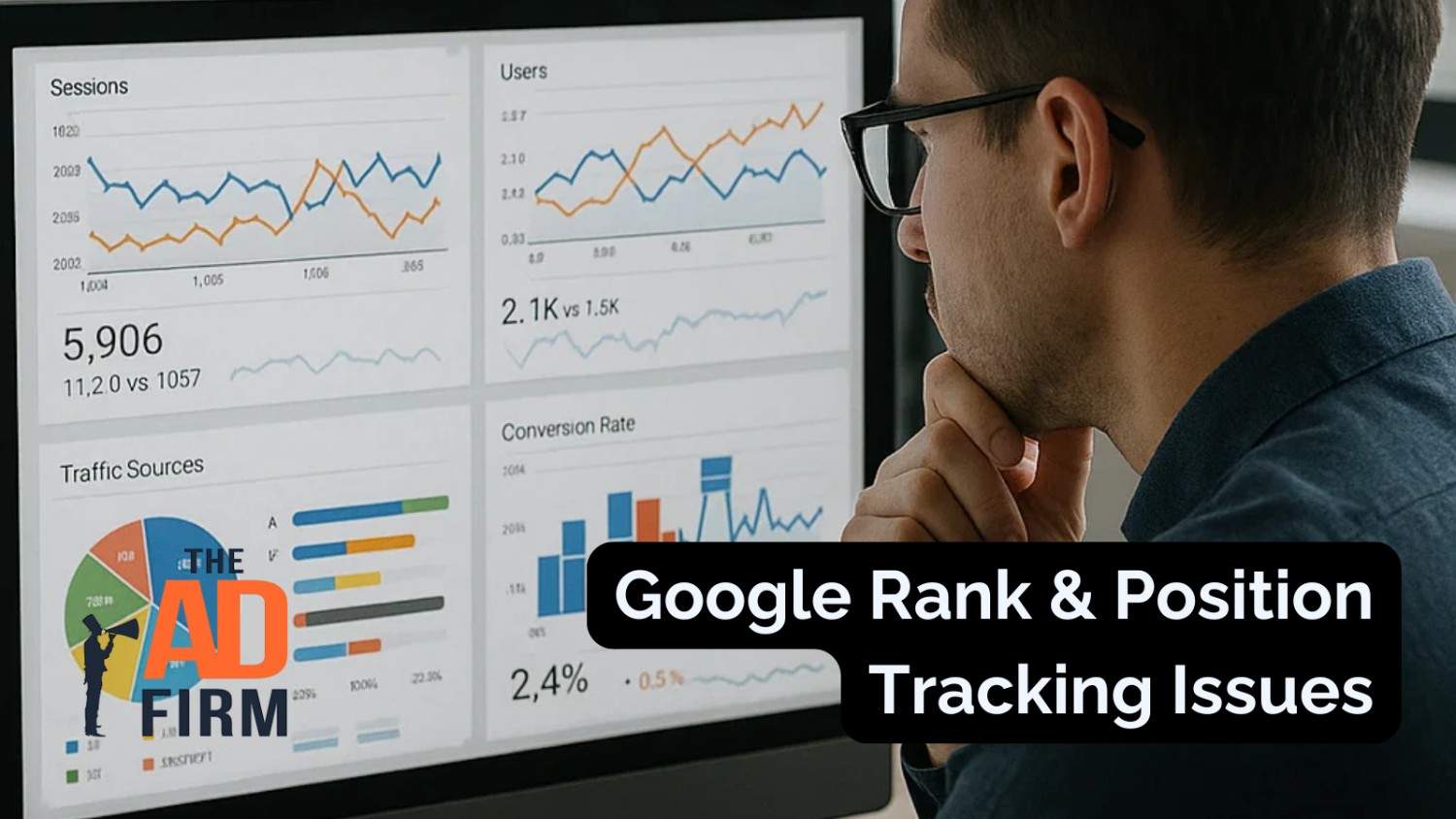First noticed and reported in mid-September, Google is currently experiencing rank and position tracking issues that are impacting SEO professionals worldwide.
Reports from both Google Search Console and third-party tools have shown inconsistencies, leaving businesses and marketers questioning their data. These disruptions make it harder to track progress, align strategies, and communicate accurate results to clients.
Many have already noticed sudden drops in impressions or unusual spikes in rankings that don’t match traffic patterns. The problem is affecting everyone—from small site owners to large agencies—and even the most trusted SEO tools are showing unreliable insights.
In this blog, we’ll break down what’s happening with Google rank and position tracking right now, why it matters, and what steps a professional SEO company and website owner should take to adapt.
Why Google Rank and Position Tracking Was a Mess
The tracking environment for Google rankings became unstable when sudden shifts in reporting left SEO experts without dependable data. What appeared in one tool didn’t match another, and even Google’s own Search Console raised questions.
The root of the problem came from changes Google made that disrupted how ranking information was collected.
Key reasons behind the mess included:
- Inconsistent reporting between Google Search Console and third-party tools
- Sudden drops in impressions and spikes in average position metrics
- Removal of familiar ranking data methods without prior notice
- Technical challenges in how tracking tools retrieve deeper search results
- Increased challenges in validating rankings across different platforms
This situation left many professionals second-guessing the data before them. Was the drop real, or just a reporting issue? Were client rankings truly slipping, or was the system itself unstable? These questions added unnecessary complexity to daily SEO work.
The result was a period of confusion that forced site owners and agencies to pause and reassess their strategies. Tracking accuracy is the foundation of measuring search visibility. Without it, every insight, plan, and report becomes harder to trust.
Timeline of the Change
The disruption to Google rank and position tracking didn’t happen overnight. It unfolded across several days, leaving SEOs unsure of whether they were dealing with a bug, a glitch, or a permanent shift. Here’s a quick breakdown of how the change rolled out and how the industry responded:
Advance Your Digital Reach with The Ad Firm
- Local SEO: Dominate your local market and attract more customers with targeted local SEO strategies.
- PPC: Use precise PPC management to draw high-quality traffic and boost your leads effectively.
- Content Marketing: Create and distribute valuable, relevant content that captivates your audience and builds authority.
Sept 12–13, 2025 – The &num=100 parameter effectively stops returning 100 results per query.
Sept 15, 2025 – The SEO industry begins to notice widespread rank and position tracking chaos. Reports emerge of impression drops in Google Search Console desktop data, along with unusual spikes in average position metrics.
Sept 18, 2025 – Google confirms that the parameter was never officially supported. What many believed was a bug is clarified as an intentional change.
Vendor Notes – Shortly after, major rank tracking providers like Semrush and AccuRanker publish impact statements and workarounds, advising users on how to adapt their reporting and expectations moving forward.
Google’s Confirmation of This Issue
When questions first started circulating about the missing ranking data, many wondered if it was a temporary glitch. Similar issues had surfaced in the past, so SEO professionals expected Google to clarify quickly. Instead, it took several days before any official response was given.
Google has finally confirmed that the results-per-page parameter used to display 100 search results was not a supported feature. Although digital marketing professionals had relied on it for years, Google stated it was never part of its formal documentation. This meant the change was not a bug but an intentional adjustment, leaving tracking tools and SEO experts to adapt on their own.
The lack of transparency left room for speculation, particularly among professionals managing large websites and local SEO automation services. Without advance notice, the shift caused disruptions in data reliability and forced agencies to re-examine how they gather and interpret ranking information.
The Real Reasons Behind Google’s Decision to Disable This Feature
Google did not provide details about why it made this change, but several likely reasons are apparent. The parameter made it easier for tools and scrapers to collect data at scale, something Google has always discouraged. By removing it, Google limits automated scraping that can place heavy strain on its systems.
Another factor may be the integrity of impression data within Search Console. SEO specialists noticed significant declines in impressions after the change, raising questions about whether past data had been inflated by bot activity. Disabling the parameter could lead to cleaner, more accurate reporting over time.
Elevate Your Market Presence with The Ad Firm
- SEO: Boost your search engine visibility and supercharge your sales figures with strategic SEO.
- PPC: Target and capture your ideal customers through highly optimized PPC campaigns.
- Social Media: Engage effectively with your audience and build brand loyalty through targeted social media strategies.
There may also be performance and consistency benefits for Google itself. Standardizing how search results are served ensures uniformity across devices and regions.
While Google has not provided a direct explanation, these factors combined give insight into why the change was likely a calculated move rather than an accidental disruption.
The Impact on Tracking Tools
The removal of the results-per-page parameter reshaped how ranking tools operate. These platforms relied on the feature to quickly and efficiently pull large datasets at lower costs. Without it, their systems now require far more resources to gather the same information.
This change disrupted pricing models, reporting accuracy, and overall performance. For SEO professionals and agencies, it created more uncertainty in day-to-day work. To understand the full scope, let’s break down the main areas of impact.
Increased Costs for Retrieving Ranking Data Beyond Page One
Before the change, most rank trackers could capture the top 100 results in a single query. Now, they must run 10 separate queries to collect the same amount of data, each returning just 10 results. This creates a direct increase in costs and processing time for these platforms.
For tool providers, higher operational costs often translate to either reduced features or increased subscription prices. Some companies may pass these expenses on to customers, while others may limit the depth of reporting to save resources.
Both scenarios affect how SEO specialists access and interpret ranking data.
The biggest challenge lies in scalability. Agencies managing hundreds of clients will find that retrieving more in-depth ranking data requires more time and a larger budget. This shift pushes many professionals to prioritize first-page rankings, as the cost of tracking further pages grows less practical.
Data Gaps and Inaccuracies in Historical Tracking Reports
Tracking consistency has also taken a hit. Historical ranking reports were built using the old system, which provided complete visibility into the top 100 results simultaneously. With the methodology now changed, comparisons between old and new data may not align.
This creates confusion for businesses trying to measure long-term progress. A ranking that once appeared stable may now seem inconsistent simply because of the new data collection method. Explaining this to clients requires careful communication and additional context.
Amplify Your Market Strategy with The Ad Firm
- PPC: Master the art of pay-per-click advertising to drive meaningful and measurable results.
- SEO: Elevate your visibility on search engines to attract more targeted traffic to your site.
- Content Marketing: Develop and implement a content marketing strategy that enhances brand recognition and customer engagement.
For agencies focused on future-proofing SEO with AI, these disruptions highlight the need for more adaptable systems. Relying too heavily on one type of ranking data introduces risks. Moving forward, blending multiple data sources and investing in smarter tracking methods will become essential.
Technical Challenges in Adapting to the New Search Results Structure
Rank-tracking platforms also face significant technical hurdles. Their systems were designed to operate efficiently under the old structure, and removing the parameter forces a complete redesign. Rewriting processes to handle multiple queries simultaneously is both complex and time-consuming.
Some providers responded quickly, releasing updates or issuing statements to users about expected disruptions. Others lagged, leaving customers frustrated by delays and inaccuracies. The speed at which these companies adapt now becomes a competitive advantage in the crowded SEO tool market.
In addition to system redesigns, user interfaces may also require rethinking. Many dashboards were built to present the top 100 results in a single view. With the parameter removed, new approaches to displaying rankings will be necessary to maintain usability and value for end-users.
What SEO Professionals and Website Owners Must Do Now
The recent changes highlight the importance of flexibility in SEO. Data that once felt dependable can shift overnight, leaving professionals scrambling to adjust. Adapting quickly is crucial for maintaining clarity and confidence in reporting.
For SEO experts and business owners, this means reevaluating how ranking data is collected, reported, and used. It also requires an open approach to testing new tools and leaning on first-party insights. Let’s look at the most critical actions you should take now.
Verify Your Current Ranking Data Against Multiple Sources
Relying on a single platform for ranking data is no longer enough. Each tool interprets and collects results differently, especially after the parameter change. To minimize confusion, SEO professionals should cross-check results across at least two or three platforms.
This doesn’t mean you need to invest in every rank tracker available. Instead, it’s about creating a validation process that ensures your insights are grounded in consistent evidence. If multiple sources reflect similar trends, you can be more confident in making decisions.
Streamline Your Digital Assets with The Ad Firm
- Web Development: Build and manage high-performing digital platforms that enhance your business operations.
- SEO: Leverage advanced SEO strategies to significantly improve your search engine rankings.
- PPC: Craft and execute PPC campaigns that ensure high engagement and superior ROI.
Verification also helps avoid false alarms. A sudden drop in one tool is a reporting quirk. Cross-checking protects you from reacting too quickly to misleading signals and maintains a stable strategy.
Adjust Client Reporting to Account for Temporary Data Discrepancies
Client communication has always been central to SEO, and the current situation makes it even more critical. Reports may show metrics that appear alarming, like drops in impressions or unusual average position changes. Without context, these shifts could cause unnecessary concern.
Agencies and freelancers should proactively address these issues in their reporting. Explain why the discrepancies exist and clarify that they stem from changes in Google’s systems rather than client performance. Transparency builds trust and reassures clients that the situation is under control.
Adjusting reporting templates or adding explanatory notes may feel like extra work, but it prevents confusion. This approach ensures that your clients stay informed and focused on long-term results rather than reacting to temporary noise.
Shift Focus Toward First-Party Data from Google Search Console
Third-party rank trackers are still adjusting to the recent changes, which makes Google Search Console the most dependable source of performance insights right now. Since the data comes directly from Google, it reflects actual user queries, clicks, and impressions without relying on unstable third-party methods.
To make the most of Google Search Console during this transition:
- Check performance reports regularly. Track impressions, clicks, and average position to see how your site is appearing in real searches.
- Use query-level data. Review the Queries report to identify which search terms are still driving traffic and spot sudden drops or gains that might not appear in external tools.
- Segment by page and device. Compare performance for individual pages and devices to understand where changes are happening.
Although Google Search Console doesn’t provide the same depth as traditional rank tracking, it offers actionable data on how real users are engaging with your site. Combining these insights with analytics platforms gives you a clearer picture of how search visibility translates into traffic and conversions.
Evaluate and Update Your SEO Tool Stack Based on Adaptation Speed
Not all SEO tools are created equal, and this recent shift has made that more obvious. Some platforms adapt quickly, while others take weeks to roll out fixes. For professionals managing multiple sites, relying on slower tools can create unnecessary delays and frustrations.
Transform Your Online Strategy with The Ad Firm
- SEO: Achieve top search rankings and outpace your competitors with our expert SEO techniques.
- Paid Ads: Leverage cutting-edge ad strategies to maximize return on investment and increase conversions.
- Digital PR: Manage your brand’s reputation and enhance public perception with our tailored digital PR services.
Evaluating your current tool stack is an important step. Look at how quickly your providers responded, how transparent they’ve been with updates, and how stable their new reporting looks. If a platform continues to struggle, it may be time to explore alternatives.
Investing in tools that innovate quickly provides long-term stability. The SEO landscape will continue to evolve, and providers who adapt quickly will maintain more consistent and trustworthy data over time.
Wrapping It Up
The recent changes in Google rank and position tracking created confusion, but they also revealed how dependent the SEO industry had become on outdated methods. With the removal of the parameter, professionals are now adjusting to a new normal in how ranking data is collected and analyzed.
This shift highlights the importance of flexibility and clear communication. SEO experts who verify data across multiple sources and rely more on first-party insights will be better prepared. It’s a reminder that search performance should always be measured in terms of real user impact, not just position numbers.
Working with a trusted digital marketing agency can help businesses adapt faster. Agencies bring experience, updated tools, and strategies that align with Google’s evolving standards. While the tools will catch up, having expert guidance ensures your site stays competitive through every change.
If you need help in navigating these changes, please contact our team at The Ad Firm, and we’ll help.







